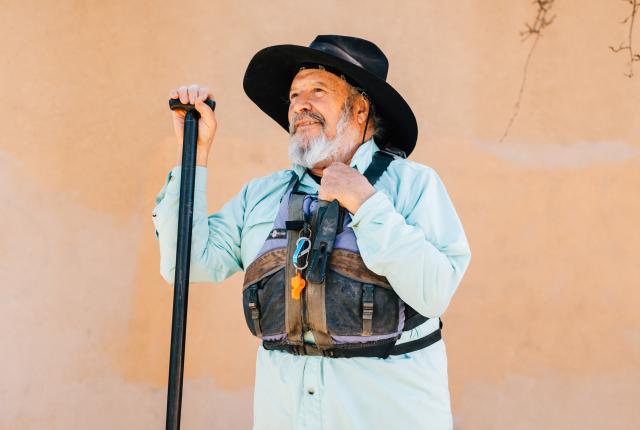IN 1973, CISCO GUEVARA STOOD OUT as a rare New Mexican river runner who knew how to handle the Taos Box, some of the roughest whitewater on the Río Grande. He was hired at Los Rios River Runners shortly out of high school, making $25 a day—“big money back then,” he recalls—to guide rafts down those rapids. He took over the company in 1978.
THE THING THAT MAKES NEW MEXICO DIFFERENT is the native cultures—the Hispanic-mestizo and Native American cultures. That variety goes hand in hand with the variety of terrain. We have a wide range of geological features and life zones. We have a complete variety from desert to alpine.
We’re in the middle of a very vibrant, very old culture and civilization that has a tremendous amount of history. When you think of the Río Grande, we’re talking a really long, old, wild history, so being in the middle of all that lends an extra level of experience to whitewater rafting.
[For the Native Cultures Feast and Float] we pass through traditional hunting and gathering grounds for the Native tribes here. One thing we’ve learned is there’s great reward, great experience, and a certain type of thrill in floating on flat, scenic, calm water with a Native guide. It’s a growing part of our market, our product, because the big, adrenaline-filled, white-knuckle whitewater is becoming more and more rare in this high desert we live in due to a variety of factors, including the ongoing drought.
River runners have known for a long time that being on, in, or near moving water has the ability to refresh us, physically, mentally, and even spiritually—and science has proven that. There’s a good chance of healing and balance and rejuvenation that can happen for you, as well as learning about the culture and enjoying the spectacular scenery.
I LEARNED THE HARD WAY
Wear a Life Jacket
As a kid, Cisco Guevara and friends would ride the Río Grande with inner tubes over Class III rapids. “I remember several times pulling my peers out of the river semiconscious, bloody, and near death,” he says. Even after combining inner tubes, the results were the same. Eventually the local Boy Scout leaders stepped in. “They were like, ‘We heard what you boys have been doing. Why don’t you wear life jackets?’ Oh! Wear a life jacket—a properly fitting one.”


